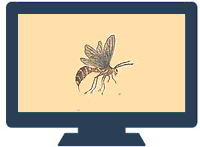Entomology, Department of

Department of Entomology: Distance Master of Science Projects
Date of this Version
2018
Document Type
Project
Citation
University of Nebraska-Lincoln Department of Entomology Online Masters Program Final Project. Lincoln, Nebraska.
Abstract
West Nile virus (WNV) has become established across the U.S. with heightened activity causing significant human illness. Monitoring methods to predict the risk of human infection are urgently need to initiate timely preventative measures and justify the expense of implementing costly or unpopular control measures, such as aerial spraying or curfews. This research outlines several ways to further improve the productive power of monitoring mosquitoes. These results demonstrate that mosquito monitoring provides a valuable public health tool for assessing the risk of human arboviral infections, allocating limited public health resources, and justifying emergency control actions.
A key challenge has been identifying a monitoring method that would signal impending human infection and be reliable enough to be used to justify expensive control efforts. The results show that standardized mosquito monitoring provides strong predictive power to signal human WNV infection up to several weeks in advance and is a valuable tool for public health officials. Given the 2012 WNV epidemics, the most promising find is that high values of the risk index have extremely high negative predictive value and strong positive predictive value. This suggests that waiting to take costly actions to control WNV when vector risk indices are low will nearly always be prudent, and taking costly actions to control WNV when risk indices are high is strongly warranted. It is worth noting that determining “high” and “low” values of vector indices required analyses of data from the area where control actions are being considered.
The results provide guidance on the most effective way to estimate the prevalence of vector infection by using mosquito trapping and testing data, which can be challenging for arboviral monitoring because of the very low prevalence frequently observed. If local trapping efforts yielded too few mosquitoes to accurately estimate prevalence, then the vector index should be calculated by using prevalence estimates for each mosquito species from regional or statewide trapping efforts for that week. In contrast, if trapping efforts over a 2 –week period within a single county produce sufficient numbers of mosquito pools to adequately estimate WNV infection prevalence, then a vector index using a 2-week estimate of prevalence can be used to predict human infection up to 3 weeks later.
The results suggest that, the link between WNV entomological risk and human risk is strong enough that predictive relationships are not obscured by unmeasured variation in these other factors. They also suggest that even a single set of mosquito traps placed in each county can provide useful information for allocating disease control efforts. The findings indicate that active entomological surveillance provides a robust and valuable method to determine the risks of human infection with arboviruses like WNV. Resources to support these efforts and the trained personnel required to carry them out should be reduced by budget tightening. To do so in an era of environmental change and rapid international movement of vector-borne pathogens could be perilous.
The goals or objectives of the project is to provide an overview of mosquito monitoring, how it works, the different types of trapping that can be used, its effectiveness on eradicating WNV, and the application of insecticides. The application involves a tedious and well documented way on how these pesticides are used. The project also outlines how community agencies, residents, and county officials work together to resolve the issue of WNV.
Although West Nile in Los Angeles County has decreased in recent years, there is still substantial work that needs to be completed. This includes improvements in Mosquito Control Measures, documenting and filing reports, and using fewer insecticides and more natural methods of controlling mosquito populations.


Comments
Copyright 2018 Elisa Gonzalez